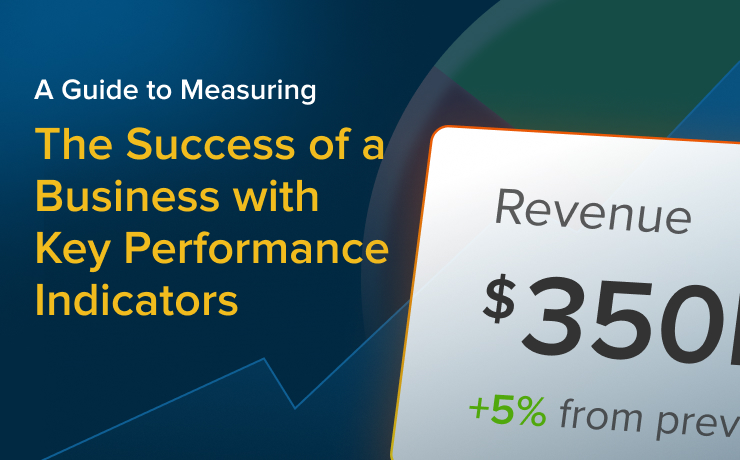A Guide to Measuring the Success of a Business with Key Performance Indicators

Axelle Andrew
Project Manager

Measuring business success can be challenging without proper metrics. Key Performance Indicators (KPIs) enable companies to identify strengths and weaknesses, make data-driven decisions, and optimize for future growth. This guide explains the fundamentals of KPIs, their importance in business management, and how to implement and use them to measure business success effectively.
What are KPIs and Why are They Important in Business Management?
KPIs, short for Key Performance Indicators, are quantifiable metrics that businesses can implement to make data-driven decisions. In business management, KPIs can aid in optimizing results and business initiatives by setting goals, measuring performance, and making results-driven, well-informed decisions.
Below are just a few other ways KPIs can be essential in your business:
Accountability
The use of KPIs can aid in creating a sense of accountability by addressing team performance and result output. This can facilitate a sense of responsibility which may motivate team members to not only meet expectations but also strive for better.
Strategy development
By focusing on certain metrics, KPIs can also aid businesses in developing everyday tasks that align with the company’s goals and objectives.
Communication
The use of KPIs is a universal language in and of itself. They are a great way to communicate progress and achievements as well as challenges through hard data.
Improvement
KPIs can help refine a company’s objectives by highlighting areas of improvement. Long term tracking of performance can help businesses grow by identifying trends, setting higher goals and expectations, and setting new targets to drive business success.
Essentially, KPIs are important metrics for businesses as they provide insights to help in planning, strategizing and execution of your overall business’s goals and objectives.
Types of KPIs You can Use to Achieve Business Success
Though there are many different ways to use KPIs throughout various industries, below are a few general indicators that can be applied to any industry:
Revenue Growth
This KPI tracks the overall sales revenue over a period of time. This works by providing data on your business’ financial performance and overall success.
Return on investment (ROI)
This indicator measures the financial return of an investment in relation to the initial cost of the investment itself. This is important by aiding businesses in assessing the effectiveness of investments in various areas such as digital marketing, labor, technology and other initiatives.
Customer satisfaction
This tracks a company’s overall customer satisfaction through feedback such as surveys, reviews, or referrals. This can give insight into whether or not the company’s product or services are satisfactory and can also identify areas of improvement.
Employee satisfaction
Akin to customer satisfaction, a company can measure employee satisfaction through similar means such as anonymous surveys and feedback. Gaining insight from your employees is a great way for your company to retain employees, gain loyalty and ultimately build a strong foundation from within.
Traffic and conversion rates
These KPIs record the amount of visitors your website receives and can be a great indicator to measure your company’s online presence. Conversion rates measure the amount of visitors who decide to buy your product or service. This is a great metric to discern whether your website layout has a great or not-so-great user experience.
Social media engagement rates
This records the number of likes, comments, shares, and overall engagement your social media content receives. Companies can utilize their social media platforms for branding, and media presence by using these key metrics to identify areas for organic growth.
Though there are many more key performance indicators businesses can use to measure success, these are just a few general ways to assess areas of improvement, refine objectives and strategize.
Key Considerations for Implementing KPIs
Though KPIs are a great tool to help measure the success of your business, there are some considerations to take before implementing them. A few things to consider are how relevant certain KPIs are for your business. For example, a food truck business would not have the same key insights as a retail clothing store. All businesses should consider the KPI’s relevance to the business, as well as whether or not the data measured aligns with the business’s goals.
Another key aspect to consider is the frequency in which you report your measured data. How often your business measures the data presented is just as important as the data itself. Oftentimes businesses will have deadlines for reports, i.e., weekly, monthly, quarterly, or yearly. All of which can measure the success and growth of your business over a period of time. This is a great way for businesses to identify long-term trends that can aid in making important decisions for future campaigns and other initiatives.
Last but not least, ensure that the key performance indicators that you choose to integrate cover the most important aspects of your business, from financial and operational to marketing and customer satisfaction. It is best to avoid focusing on one area at the expense of others. Having a broad scope of specific KPIs can link data that aren’t typically within the same department, which can aid in a solidified plan of action.
How to Use KPIs to Measure Business Performance
There are numerous online tools that can help track your KPIs through visuals such as charts that measure revenue, traffic, social media engagement, and more. Tracking KPI progress over time can help identify trends and patterns for a business. For example, a pool servicing company can expect lower revenue months in the winter seasons because that is a trend for the business’ niche. When looking at their KPI results, they can strategize by cutting costs during winter. On the other hand, a financial consulting business that has been on a steady rise takes a sudden dip in revenue that was not expected. They can now re-strategize to strengthen their business by pinpointing any areas that may need optimization.
It is important to note that reviewing your business objectives every so often while reviewing data that has been provided by your KPI metrics are great and necessary ways to see the overall growth of your company in various areas.
Common KPI Implementation Challenges and Pitfalls
KPIs provide very solid insights into business performance. There are still some common KPI pitfalls to avoid:
Focusing on too many or too few KPIs
One common mistake during keyword implementation is focusing on too many keywords at one time. This can cause an overload of information making it more difficult or confusing to focus on the main metrics at hand. Focusing on too few KPIs can leave many holes in your business’ ability to strategize. There may not be enough information collected to effectively do so.
Not aligning KPIs with business goals
It is always important to make sure the KPIs that are being measured are in direct correlation with your business’ objectives. Focusing on KPIs that do not necessarily matter to the business can result in a lack of organizational direction. This can take away focus from the metrics that do matter. For example, a food truck would not need to focus too much on click-through rates when compared to an online e-commerce clothing store.
Inability to adjust overtime
Businesses looking to grow and expand should also be ready to adapt under different circumstances. This also means that KPIs should be regularly reviewed and updated based on the company’s needs.
Being unrealistic
Setting unrealistic goals is another common pitfall that new business owners may fall into. The excitement of beginning a new project or business can mean setting high yet vague expectations at the start. It’s always a great reminder to set measurable expectations that are achievable, timely, and relevant.
How to Effectively Communicate KPI Results
Now that we fully understand the importance of KPIs and how to implement them, knowing how to communicate those results is the next step. Part of effective communication is knowing who you are communicating with, and what you are trying to communicate. It is important to be clear and use less jargon to ensure it’s easy for your audience to understand the data.
Visuals are one of the most basic ways to communicate data. From datasets and charts, to tables and diagrams, these are great ways to gather information and organize it into simple, easy-to-understand imagery. When using visuals, adding context is key to ensuring your audience is well-informed.
Another great point of clear communication is to focus on the key takeaways. A deep understanding of what the data means allows you to highlight important KPI result segments. When communicating, always remember what the KPIs’ objectives are and the meaning of the results.
In essence, Key Performance Indicators can measure your business’ success by providing specific insight into the most important areas of your business. They are a guaranteed way to ensure a business remains stable and successful. Now that you know what Key Performance Indicators are and how to effectively use them, you can go ahead and start implementing them the right way.
 Free
Consultation
Free
Consultation Free
Google Ads Audit
Free
Google Ads Audit







